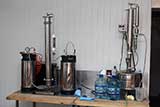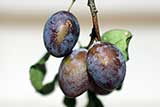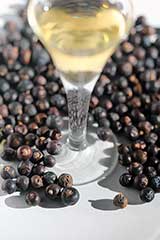Meats and Sausages
Vodka Types
The popularity of vodka can be attributed to two factors:
- It has a neutral taste and color so it becomes a base for many other mixed drinks.
- It is very easy to make - it is made by diluting pure alcohol.
There are three types of vodkas:
- Plain vodkas
- Flavored vodkas
- Fruit vodkas
Plain vodkas are made from 95% alcohol. Superior quality types like "Wyborowa" are made from 96.5% alcohol. Plain vodka is the simplest, the most unsophisticated alcoholic beverage of them all, consisting of essentially nothing else than a mixture of 40% ethanol (C2H5OH) and 60% water (H2O). Of course, there may be small amounts of impurities in the brew, but they are truly minute. Because it has no taste, the explanation that someone likes the taste of it makes little sense. What we really like is that it kicks our head. When we say this vodka tastes good we really mean that the vodka has a clean, smooth, neutral taste. And having a neutral taste means no taste at all.
It is relatively easy to recognize a good quality spirit. If you drink plain vodka and your body demands a chaser you have a regular vodka type. This is why such vodkas need to be mixed with sodas or orange juice, because they leave an unpleasant taste. This is of course due to the quality of alcohol that was used to make it. You can drink top quality plain vodka without shaking and you do not need a chaser. There is no unpleasant feeling in the mouth. Using 95% alcohol for making vodka is not a guarantee of a top quality product. If not enough head (first 3-4% of distillate) was removed, or distillation continued too long and too much tail (last 3-5% of distillate) remained in the distillate, the quality of heart (main, pure alcohol) will be poor even if its strength remains at 95-96% level.
Flavored Vodkas
What has become very popular in recent years is flavored vodka. Flavored vodkas are not new, about 100 different types were once produced in Poland. Fruit vodkas and alcohol based fruit drinks were always popular in Poland, Russia or Germany. However, Russians deserve the credit for recognizing the opportunity and bringing flavored Stolichnayas to the American market. The trend was immediately copied by other manufacturers and flavored vodkas became a hit. Today the following brands produce the majority of flavored vodkas: Stolichnaya - Russian, Finlandia - Finland, Absolut - Sweden. In the USA vodka outsells other spirits like brandy, cognac, gin or whisky. For many years vodka was just pure alcohol 95-96% that has been watered down to 40% (80 proof) strength.
This resulted in a clear spirit of a neutral taste, providing the alcohol was of a good quality. This definition has recently been expanded as there are dozens of lemon, orange, plumb and raspberry flavored vodkas which entered the market. They share the common denominator - they are all 40% (80-proof) strong. They start to resemble Polish and Lithuanian infusions which have been always produced in Polish and Lithuanian households.
As the name implies flavored vodkas are very different. They are supposed to be different from plain vodkas. This type of vodka can easily be made at home. Making any kind of vodka requires alcohol, so it is crucial that we understand its properties. Alcohol is mixed with water to produce plain dry vodkas and is added to fruit juices or infusions to make fruit vodkas. You can also make a fruit flavored vodka from a fruit distillate. Alcohol distillates can be produced from fruits, grains, potatoes, molasses or flavored alcohol infusions.
Depending on the amount of sugar alcoholic beverages may be classified as:
- Dry - up to 50 g (5%) of sugar per 1 liter of vodka. There are very few types of vodka without any added sugar at all. Adding as little as one teaspoon/liter (0.04%) of sugar smoothens the taste of regular vodka.
- Semi-dry - 51-120 g/l (5-12%).
- Semi-sweet - 121-220 g/l (12-22%).
- Sweet - 221-330 g/l (22-33%).
- Liqueurs - 331 g/l and more (> 33%).
- Crèmes - 400 g/l or more (> 40%).
We do not necessarily have to follow those standards, but they at least provide a reference point. There is a very fine line that separates sweet flavored vodka from a liqueur. You can make both from the same fruit, for example from sour cherries, although the liqueur will usually incorporate more sugar. What one person calls sweet vodka another might call a liqueur. The main advantage of creating alcoholic spirits at home is that one is in total control of the process. One does not have to conform to the government's standards and he can choose the strength of his drink, the amount of sugar or the shape of the bottle. One can experiment a lot, or change the composition of his recipe on a whim, something that the factory cannot do. Factories use automated lines to fill the bottles and increasing the amount of sugar or changing the shape of a bottle will disrupt the production routine.
Fruit and Herbal Vodkas
These vodkas are made from fruit or herb infusions. They take more time to produce but their flavor, aroma and color is better than anything that is made commercially.
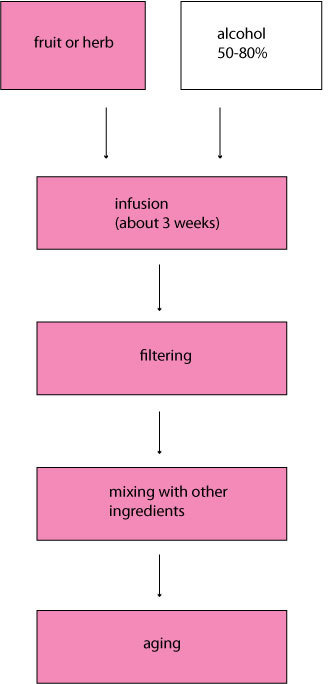
Fruit and herbal vodkas.
Natural Distilled Vodkas
Natural distilled vodkas are made from fruit or herbs. Great liqueurs are made in the same manner. This method requires distilling equipment and distilling any type of alcohol is outlawed in the USA and most other countries.
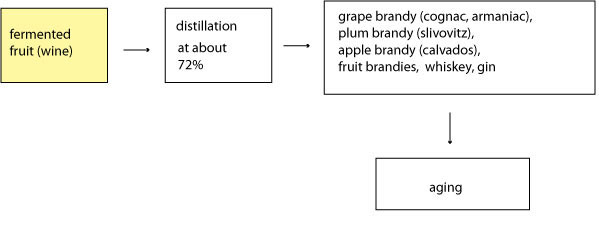
Natural vodkas.
Grape Brandies
Brandy (from brandywine, derived from Dutch brandewijn - "burntwine") is a spirit produced by distilling wine. The wine is heated ("burnt"), vaporized and then cooled becoming brandy. Grape vodkas were originally made in France and were c alled "eau-de-vie" (vodka from wine). The strength of the distillate is 60-75%, anything strongerwill remove too many substances that contribute to the peculiar flavor of brandy or cognac. Then it is aged for 3-5 years and diluted to around 40%. Brandies may be considered a type of flavored fruit vodka as the technology remains basically the same for making other distilled spirits.
Armagnac is a distinctive kind of brandy produced in the Armagnac region in Gascony, southwest France. It is distilled from wine usually made from a blend of Armagnac grapes, using column stills rather than the pot stills required in the production of Cognac. The resulting spirit is then aged in oak barrels before release. Armagnac was one of the first areas in France to begin distilling spirits, but the brandies produced have a lower profile than those from Cognac and the overall volume of production is far smaller. In addition they are for the most part made and sold by small producers, whereas Cognac production is dominated by big-name brands.
Armagnac is traditionally distilled once, which results in a stronger, more pronounced flavor than that of cognac, where double distillation usually takes place. The distillate is about 52-60% strong. However, long aging in oak barrels softens the taste and causes the development of more complex flavors and a brown color. When the alcohol reaches 40%, the Armagnac is transferred to large glass bottles for storage. From then on the Armagnac does not age or develop further and can be bottled from the next year on.
Cognac, named after the town of Cognac in France, is a certain type of brandy. It is produced in the wine-growing region surrounding the town from which it takes its name. For a distilled brandy to bear the name Cognac, its production methods must meet certain legal requirements. It must be made from specified grapes and the wine must be twice distilled in traditional copper pot stills to about 70% alcohol. Then it is aged at least two years in French oak barrels from Limousin or Tronçais oak trees.
Fruit Brandies
Calvados is an apple brandy from the French region of Basse- Normandie or Lower Normandy. The fruit is pressed into a juice that is fermented and distilled. The best calvados are made in the Pays d'Auge region. Double distillation is carried out in a traditional alembic pot still; the first distillation to 30% alcohol strength, the second distillation to 65-70%. Then it is diluted to about 50% and aged for 2 years in oak casks. Then, if needed, it is diluted to about 42% and bottled.
Slivovitz is a plum brandy, made from damson plums, and produced in Slavic regions of Central and Eastern Europe, both commercially as well as by many households. Primary producers are in Serbia, Czech Republic, Slovakia, Poland, Hungary, and Bulgaria. Similar plum brandies are also produced in Germany, Switzerland, France, the United States, and Canada.
The process: plums are drilled but 15-20% kernels are saved as they contain amygdalin, the characteristic component of bitter almonds. This peculiar flavor is desired in a plum or sour cherry brandy.
The fruit mash is fermented, then distilled:
- 1st distillation - 25-30%
- 2nd distillation - 70-75%
Then the slivovitz is aged for 1- 2 years in oak casks. After aging slivovitz is diluted to the required strength, often left at 70% alcohol, which makes it a very strong drink. Sugar is not added to slivovitz.
Kirsch or Kirschwasser is a clear, colorless fruit brandy traditionally made from double distillation of morello cherries, a dark-colored cultivar of the sour cherry. The technology follows the process for making slivovitz with one difference: more crushed kernels are added (20-35%), sometimes even all of them. This accounts for the strong cherry-almond flavor of the spirit. The distillate is aged in clay or glass containers in order to preserve its clear color. You may find many Kirsch liqueurs, which are colored and much weaker than brandy.
Grain Vodkas
The best Polish vodkas are made from rye:
- Superior quality dry vodkas - made from 96.5% pure rye alcohol and water, for example Wyborowa Vodka.
- Dry vodkas made from high quality rye alcohol, water and no more than 1.5 g/liter of fruit distillates or infusions.
Those vodkas are known as Zytnia Vodkas, zyto means rye in Polish. In addition there are many types of vodka that are very slightly flavored with pepper, bison grass, citrus skins and other aromatic substances.
Whiskey
Whiskey is made from fermented grain mash. Different grains are used for different varieties, including barley, malted barley, rye, malted rye, wheat, and corn. Whiskies are usually distilled twice to around 63% and aged for at least 2 years in wooden casks, made generally of charred white oak. Most whiskies are sold at or near an alcoholic strength of 40% (80 proof). There are many types of whiskey and they have different processing procedures. The following are the whiskies with the longest tradition: Scotch Whiskey, Irish Whiskey, American Whiskey and Canadian Whiskey. American Bourbon Whiskey is made from grains, but corn must account for at least 51% of the total.
Arrack
From Wikipedia: Arrack, also spelled arak, is a distilled alcoholic drink typically produced in South Asia and Southeast Asia, made from either the fermented sap of coconut flowers, sugarcane, grain (e.g. red rice) or fruit, depending upon the country of origin. Java and Sri-Lanka are islands with a long tradition of making this spirit. The clear distillate may be blended, aged in wooden barrels, or repeatedly distilled and filtered depending upon the taste and color objectives of the manufacturer. The basic materials are either rice and sugar molasses or rice and palm wine. The rice is malted, the mash is fermented, distilled and aged. The drink is clear or light yellow, around 60% alcohol strength. Arrack is not to be confused with arak, an anise-flavored alcoholic beverage traditionally consumed in Eastern Mediterranean and North African countries. In the Middle East and Near East, the term arak is usually used for liquor distilled from grapes and flavored with anise.
Rum
Rum is a distilled alcoholic beverage made from sugarcane byproducts such as molasses, or directly from sugarcane juice, by a process of fermentation and distillation. The distillate, a clear liquid, is then usually aged in oak barrels. There are two types of rum:
- Dark - strong flavor and aroma, darker color, originating in Jamaica.
- Light - Cuba, Puerto Rico. Clear rums exhibit a lighter taste and aroma.
One of the best known producers is Bacardi from Puerto Rico. The factory makes light and medium rums, from 40 to 75%. Then there are many rums which are made in Martinique, Guadeloupe, Guyana, Barbados, Belize, Nicaragua and other islands or countries located in the Caribbean basin area. This is where most sugar cane plantations have been established. However, rum is also produced in the Canary Islands of Spain, Australia, New Zealand, Fiji, Mexico, Hawaii, the Philippines, India, Mauritius, South Africa, and Canada.
The typical process consists of distilling the fermented sugarcane mash to about 70-75%. Distillation is performed twice and the distillate is usually 70-75% strong. Then it is aged for at least one year. The color of rum is influenced by the type of the aging container; the oak casks will make the rum brown but stainless containers will preserve the clear color of the distillate. Most rums are 40% grade but there are also 55% and 75% stronger ones, for example 75% Bacardi. Many rums are flavored by the addition of spices and sometimes caramel. Popular spices are cinnamon, rosemary, aniseed, or pepper. Flavored rums are infused with flavors of fruits, such as banana, mango, orange, citrus, coconut, star fruit or lime. Distilled alcoholic spirits are made with a standard method: fruit preparation, fermentation, distillation to the required alcohol strength which sometimes involves diluting distillate with water and aging. Although those spirits carry their own established names, they may be considered flavored vodkas as flavored vodkas can be a blend of different materials and flavorings.
You must realize by now that distillation is a fairly accomplished process that requires expensive equipment and a lot of space and time. What is even more important, distilling alcohol is illegal in the USA and most countries, so there is no need to go deeper into production details. However, one can buy strong alcohol and create his new combinations or imitate well known products, for example combining rum, brandy, alcohol, sugar and eggs to make a home version of Advocaat.
Gin
Gin is a spirit which derives its predominant flavor from juniper berries (Juniperus communis). The name gin is derived from either the French genicvre or the Dutch jenever, which both mean "juniper". From its earliest beginnings in the Middle Ages, gin has evolved over the course of a millennium from an herbal medicine to a popular spirit of today. There are a few popular methods for making gin:
- Juniper berries are added into 75-85% alcohol, macerated for 12 hours and distilled.
- Juniper berries are covered with 50-60% alcohol and macerated for 14 days. This is a typical infusion process. Then the infusion is distilled.
- Juniper berries are soaked in water until they release juice.
This may be repeated a few times using the juice from the previous maceration to soak new berries. It is possible to obtain 1.2-1.5 liter of juice from 1 kg of berries. Then the juniper juice is fermented for about 2 weeks. Dry juniper berries contain plenty of sugar (20-25%) and will ferment like wine. Then the juniper "wine" is distilled, filtered and aged in clay or glass containers.

